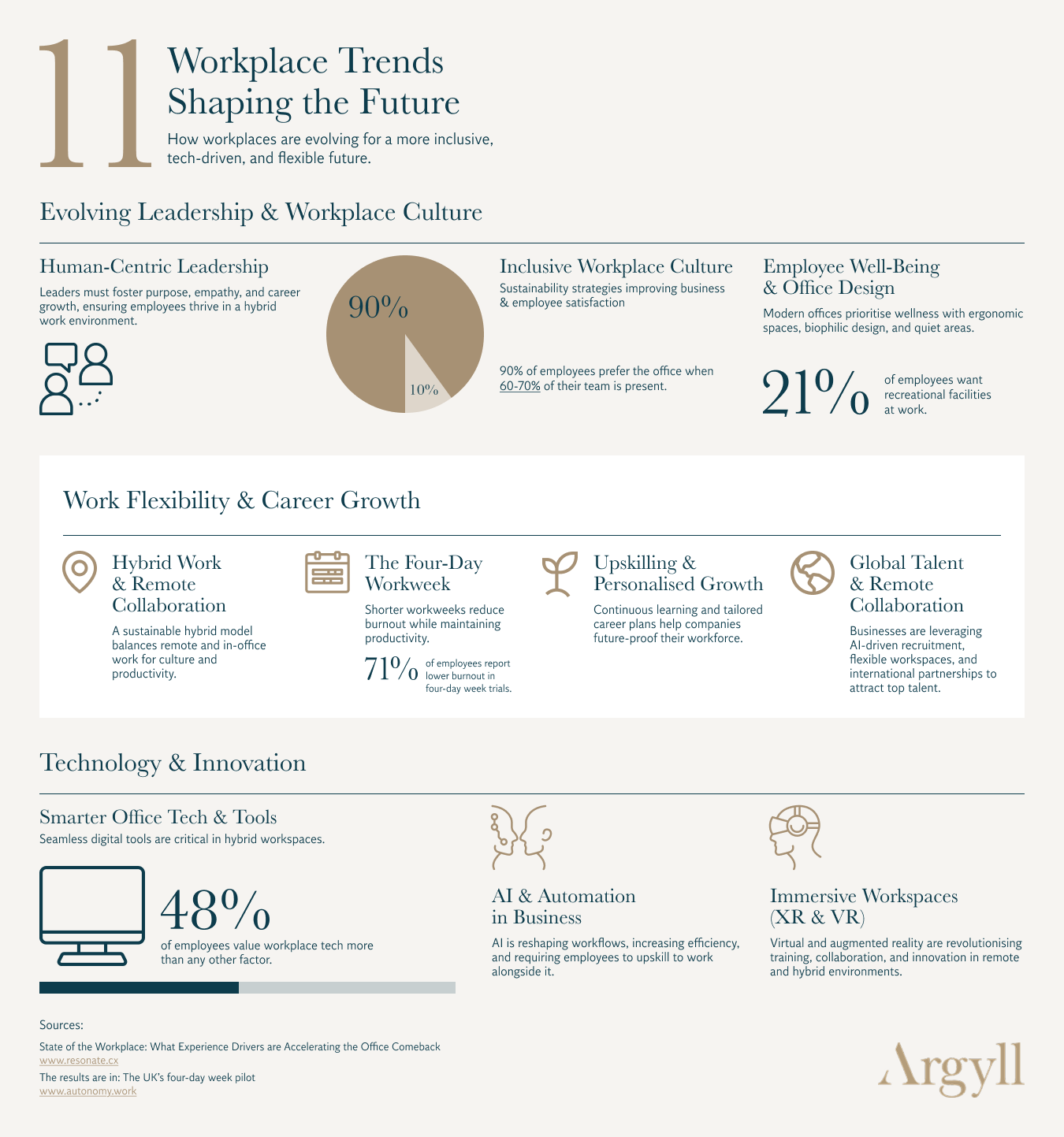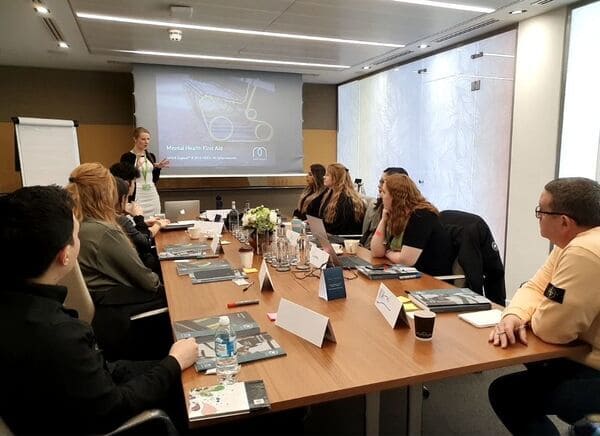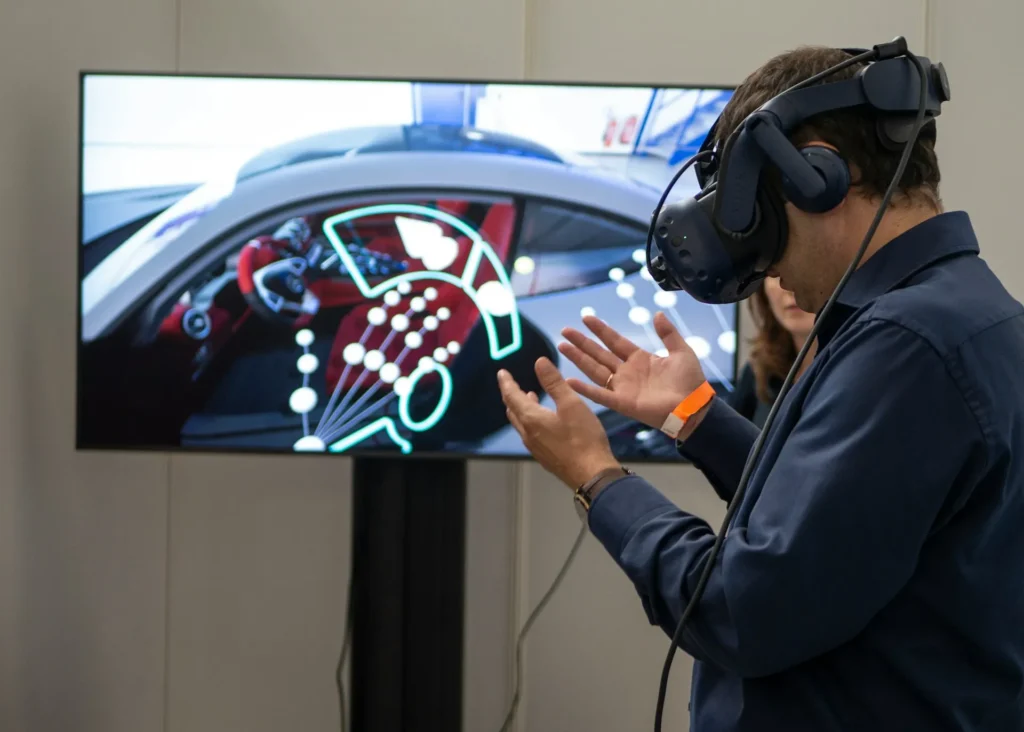The modern workplace is in a state of transformation. Advances in technology, shifts in employee expectations, and the increasing importance of sustainability are redefining how we do business. For CEOs, the future of work means balancing innovation with stability, agility with structure, and digital integration with human connection.
At Argyll, we’ve been operating exclusive office environments in London’s finest locations for over 25 years. We take pride in staying ahead of future workplace trends, ensuring we provide our clients with the office spaces they need to adapt and flourish. In this blog, we’ll explore the workplace trends shaping the corporate landscape in 2025 and offer insights into how business leaders can navigate these shifts.
Overview: current trends in the workplace
The workplace continues to evolve in line with advances in technology, shifting employee expectations, and broader societal changes. For CEOs, staying ahead means embracing innovation while maintaining strategic focus. In 2025, success will be shaped by human-centric leadership, sustainability, and smart technology integration. These trends are not just emerging — they’re redefining how we work, collaborate, and grow.
11 transformative workplace trends in 2025

Here are the top 11 workplace trends set to transform the workplace in 2025:
1. Human-centric leadership: Nurturing talent in the digital age
Leadership is shifting from directive to facilitative, with employees seeking purpose, empathy, and growth. CEOs must foster environments where talent thrives through transparent communication, active listening, and personalised career development.
In a hybrid work era where remote working is common, technology is essential for effective collaboration. Cloud-based platforms like Microsoft Teams enable connectivity, while office spaces need a variety of areas, such as video call booths and high-spec meeting rooms, to support effective communications both remotely and in person.
2. Sustainable strategies for remote and hybrid work
Hybrid work is no longer simply a temporary solution, it’s a work model that’s here to stay for the long term. Creating sustainable hybrid work strategies involves clear policies, flexible office spaces, and technology that allows seamless collaboration. Striking a balance between office and remote work keeps teams productive and connected while maintaining corporate culture.

3. The rise of green initiatives in the workplace
Business leaders need to stay focused on environmental sustainability in 2025, delving deeper into their operations to identify efficiencies and green initiatives that reduce their impact, such as responsible resource management, energy-efficient office design, and environmentally conscious supply chains. Businesses that embed sustainability into their operations will better meet environmental targets and make their business more appealing to eco-conscious clients and job candidates.
4. Solution-based thinking: global talent shortages
The competition for top talent remains fierce, with skilled professionals in high demand across industries. Forward-thinking CEOs are leveraging AI-driven recruitment, forging partnerships with educational institutions, and investing in internal development programmes to bridge the gap.
A flexible working environment is also key to attracting global talent and strengthening cross-border collaboration. Offices must provide a mix of remote-friendly technology and adaptable physical spaces, such as hot desks and meeting rooms, to support seamless communication and productivity among varied and dynamic teams.
5. Organisational restructuring: Harnessing AI and technological advancements
Artificial Intelligence (AI) and automation continue to revolutionise the workplace. Organisations must embrace AI as a tool for efficiency and decision-making. Restructuring to accommodate AI-driven workflows, integrating digital collaboration tools, and upskilling employees to work alongside AI will define future-proof businesses.
Advanced technologies are also important to employees. In their recent report, State of the Workplace: What Experience Drivers are Accelerating the Office Comeback, Resonate concluded that 48% of employees valued technology and equipment within the workplace more than any other factor.
6. Workplace culture shifts: From isolation to inclusion and belonging
A strong workplace culture is essential for employee retention and engagement. Companies are moving away from hierarchical structures and embracing inclusive, people-focused company cultures that prioritise belonging. At the heart of fostering inclusion is eliminating isolation and bringing teams together. Despite advancements in remote communication, true engagement comes from teams being physically present in the office.
According to Resonate’s report, 90% of employees appreciate being in the office when 60-70% of the team is present. As office attendance decreases, so does the perceived value. CEOs should strive for that pivotal balance to create stronger, more cohesive teams.

7. Elevating workplace well-being: Thoughtful design for nourishment and recreation
Employee well-being is a key driver of productivity. Workplace designs that incorporate biophilic elements, ergonomic furniture, wellness rooms, and recreational areas create an environment where employees can perform at their best. In 2025, organisations should prioritise mental and physical health and offer facilities that support well-being initiatives to increase engagement and reduce absenteeism.
According to Resonate’s research, 21% of people want their workplace to offer recreational facilities, while 14% look for quiet spaces to relax. Outdoor areas such as courtyards, gardens and roof terraces give employees opportunities to recharge throughout the day, while amenities that facilitate leisure activities, such as on-site showers and secure bike parking, add value to employees.
8. Normalisation of the four-day workweek
The four-day workweek is becoming increasingly popular as companies recognise its potential to enhance productivity and work-life balance. Trials across industries have shown promising results, including improved employee satisfaction, retention, and efficiency. Studies show this shorter working week can improve employee well-being with 39% of people feeling less stressed and 71% reporting reduced burnout. CEOs should assess the feasibility of this model within their organisational structure and sector.
9. Empowering employees through upskilling and reskilling
The skills required in today’s workplace are rapidly evolving. Investing in continuous learning ensures that employees remain adaptable. Personalised development programmes, microlearning platforms, and AI-driven learning pathways will enable businesses to cultivate a future-ready workforce.
10. Tailored employee experiences: Personalising the professional journey
One-size-fits-all employment models are being replaced by tailored employee experiences. From custom progression plans to flexible benefits and workspace preferences, if companies offer personalisation, they’re more likely to attract and retain top-tier professionals seeking more than just a salary.
11. Immersive workspaces: Exploring extended reality (XR) technologies
Extended Reality (XR) technologies, such as virtual reality (VR) and augmented reality (AR), are transforming training, collaboration, and innovation. CEOs should explore how immersive workspaces can enhance remote teamwork, onboarding, and product development in their respective industries.

CEO strategies for adapting to new workplace trends
These emerging workplace trends are shaping the future, but how can business leaders successfully adapt? Here are the key strategies.
Embrace AI and automation strategically
AI is a tool for enhancing decision-making and streamlining processes, not replacing human ingenuity. CEOs should focus on strategic AI that complements their workforce, optimises efficiency, and drives innovation.
Prioritise flexibility, inclusion and well-being
Adaptable workplaces, inclusive cultures, and well-being initiatives are critical for attracting and retaining top talent. Forward-thinking leaders will build organisations where employees feel valued, heard, and empowered.
Adopt agile organisational structures
Rigid hierarchies are giving way to agile, responsive structures that facilitate innovation and cross-functional collaboration. Embracing agility allows businesses to adapt quickly to respond to market changes and emerging opportunities.
Redefining the modern workplace: Exclusive office locations for exceptional results
Offering flexibility while embracing advanced technology and valuing both people and the planet is at the heart of workplace trends for 2025. If CEOs remain agile, forward-thinking, and strategic, they can adapt to these transformations, cultivate a thriving workforce, maintain their competitive edge, and redefine the future of work.
Having the right foundation for your business will be key to sustained success. Your office base needs to enhance your brand, foster collaboration, and provide the facilities you need to grow.
At Argyll, we offer exceptional office environments in London’s most prestigious postcodes. Our offices combine sophistication with flexibility, cutting-edge technology and refined interiors. Designed to meet the evolving demands of the modern workplace, our spaces set the standard for 2025 and beyond.
Contact us today to learn more.
Frequently asked questions
What are the workplace design trends in 2025?
Workplace design trends for 2025 are about creating flexible, sustainable, and hybrid-friendly offices with smart technology integration.
Which skill will be most required by 2030?
Adaptability, AI literacy, and critical thinking will be essential skills in the workforce by 2030 and beyond.
What are the HR trends for 2025?
The HR trends for 2025 include offering personalised employee experiences, AI-driven hiring, and placing more emphasis on well-being.




